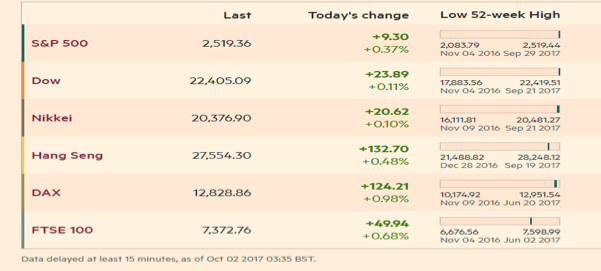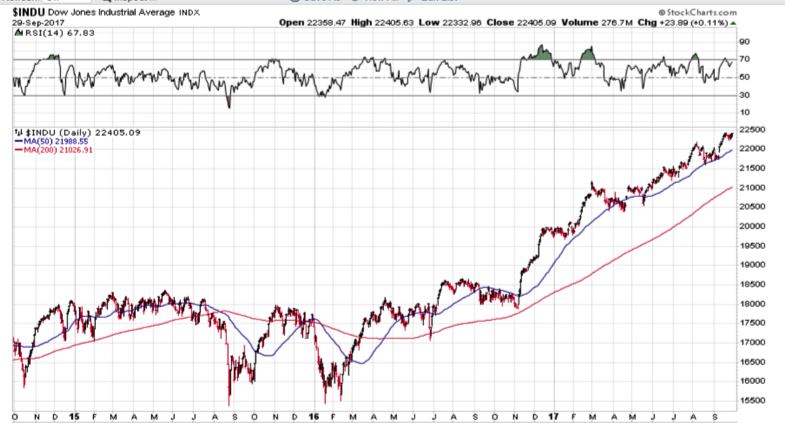The charts below, summarizing major world equity market performance, are instructive. Each has a vertical bar chart showing the range between high and low of the past 52 weeks. Virtually all markets, USA, Japan, China and European are near their 52 week highs. It has been a decade since all important world economies were expanding simultaneously. This bodes well for the future, and it is unlikely that this momentum will suddenly reverse.

Fed Chairman Janet Yellen admitted last week that Fed Governors are as puzzled as anyone as to why inflation has not fired up after 8 years of economic recovery. Economist Edward Yardeni posits that technology is rapidly replacing human labor. Since wage push inflation has historically been a factor this late into an economic recovery, the Fed seems puzzled by its absence –Yardeni accuses them of using outdated models (the Philips Curve). Most economists feel wage generated inflation is overdue as unemployment is nearing historic lows and cheap immigrant labor is going to be less of a factor at least for domestic employment in the USA. No one is quite sure of the impact due when the Federal Reserve bank unplugs from its “Quantitative Easing”, that is, maintaining the enormous float of Treasury bonds that began during the Great Recession. A dearth of T-bond buying from the Fed may be offset by demand from world of aging, conservative investors. We suspect foreign government and private sector investors will be glad to buy Treasuries even if interest rates float up by only 25 basis points. Such a small interest rate increase is unlikely to choke off our economic expansion. Pehaps the Fed can achieve its goal of normalizing its operations over the next few years, without plunging the USA and by extension, the world into a new recession. Meanwhile, equity markets ended the quarter, hopeful that meaningful corporate tax reduction may be in the offing. Not only would this improve the bottom lines of many companies, but any tax legislation is likely to include strong incentives for repatriation of profits banked offshore. If the likes of General Electric, Pfizer, Apple and Microsoft bring money into the USA and pay a low tax, these funds are expected to result in a bump up in the rate of share repurchases, placing at least a floor under the current market. Lawmakers are hoping too, that a tax windfall from companies that “ repatriate” profits will at least in part, offset personal income tax reductions contemplated. The Republicans hope to lower top rates and eliminate the confusing Alternative Minimum Tax, but the math requires elimination of many Schedule A (Itemized) deductions. It appears the hugely powerful real estate lobby will prevent curtailment of the mortgage interest deduction. However, conservatives want the deduction for state and local taxes (recently awarded the acronym “SALT”) to go away. This will be expensive for residents of high tax states such as California, New York, Massachussetts and Illinois. The conservative position is that loss of the ability to offset high state taxes with a reduction in Federal tax will turn up the heat on tax-happy legislatures and possibly slow or stop the steady creep of state and local taxes[2]. That would be a nice result if it works in California. While most Democrats will fight to keep the state tax deduction some Republicans from high tax states, notably conservative Peter King (2nd Congressional District) of New York are also opposing the notion. There is going to be a big food fight here so tax reduction for corporations is far from a done deal. The cost in lost output and for repair and reconstruction from major hurricanes in Texas, Florida and Puerto Rico will be stagerring. Still, equity markets reached new highs late in the quarter. Markets are uncannily accurate in anticipating forward conditions. Perhaps this is because market participants are confident that government can continue to borrow and spend for rebuilding, a form of economic stimulus. Many of those effected by storm damage will likely be eligible for low interest FEMA backed loans, welfare checks and eventually proceeds from private insurance and lawsuits. Despite a terrible experience and even death for those living in the hardest hit regions, financial markets have shrugged off these disasters, lending further credence to the idea that the stock bull market if not yet over. Here is a chart of the Dow Industrials going back three years: A couple of observations. Note that 2015 saw a meaningful stall, really a correction ended by what is known as a double bottom, completed at the beginning of last year. This was largely the result of a pull back in energy stocks, corresponding to a glut of oil and gas, in turn the result of the success of hydraulic fracturing in North America (too much oil and gas!) Then, even with the devisive rhetoric of an election year, the market made good progress higher and really took off once Republicans gained control of the legislative and executive branches of the Federal government. It has been nearly a year since the index tested its 200 day (one year) moving average, the red line. Three tests of the less reliable but important 50 day average have failed since last year’s election, a testament to the upward momentum in this market. Still, key measures suggest that few stocks are undervalued. With the Federal Reserve scheduled to continue tightening interest rates, or at least ceasing to pressure them lower, Schwab’s strategist Liz Ann Sonders forsees increased volatility in the next few months. For most Trusted Financial clients, this has been another quarter of portfolio gains. While most client portfolios have not grown at the same pace as have equity indexes, this is the expected outcome during strong bull markets. Our considerable allocation to bond oriented holdings have with few exceptions done remarkably well, but less well than stocks. We are confident that our clients appreciate how a balanced portfolio can protect them when equities swoon. Thank you for allowing us to be of service and please feel free to contact me with any questions. [1] News flash: it appears a large contingent of homeless Puerto Ricans, U.S. citizens who cannot be barred as “illegal immigrants” may be headed into the mainland workforce, thereby delaying labor tightness [2] On August 29, 2017 the California Supreme Court supported a breach in the fortress that is Proposition 13 by allowing special elections to raise property based taxes with less than the Proposition 13 provision that a 2/3 majority of voters must approve. For more go to this website: https://www.hjta.org/hot-topic
